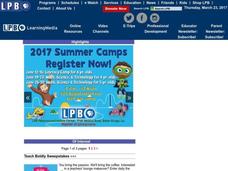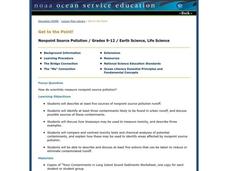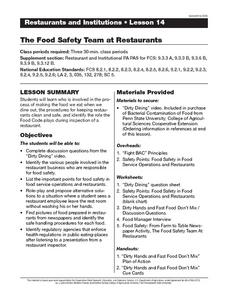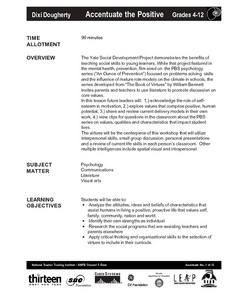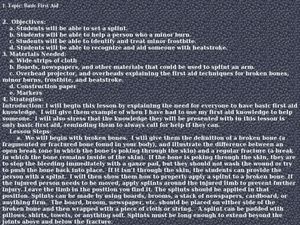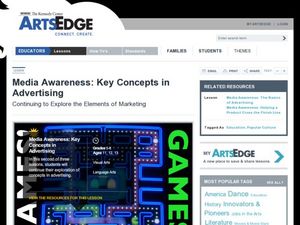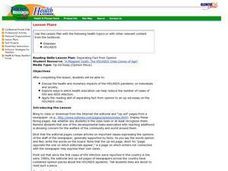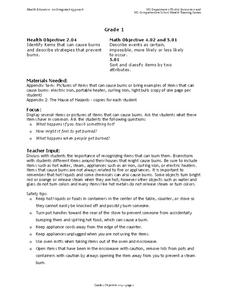Curated OER
Solar Oven
Students construct a solar oven using cardboard, duct tape, aluminum foil and other materials. They use the solar oven to cook something and keep a journal of their project.
Curated OER
Views of the American West: True or False?
Young scholars explain that a landscape painting may or may not accurately represent a specific place. They identify techniques that create the illusion of three-dimensional space on a flat surface.
Curated OER
Air Terms: The Flash Card Game
Fifth graders define vocabulary words regarding air quality. In small groups, they match magazine pictures or create illustrations for definitions and terms, and share the flash cards with their group.
Curated OER
The Awful 8: A Play
Students perform a play that presents the causes and effects on people and the environment of the eight major air pollutants.
Curated OER
Modeling Our Writing Style After Another Author's Style
Students reread "The Senegalese Miracle" from a previous lesson. As they read, they must underline as many images related to their senses as possible and share their findings with the class. In partners, they practice chunking...
Curated OER
Service Projects in the Dominican Republic
Students look into how Peace Corps Volunteers have provided community assistance in the Dominican Republic. They read primary source documents and be able to identify several kinds of service projects conducted by Peace Corps Volunteers.
Curated OER
Where There's Smoke
Students view photographs to help them see how people live in rural Nepal. In groups, they imagine what it would be like to grow up in this type of community with little food and identify the problems associated with the Nepalise homes....
Curated OER
Perspectives on Paraguay
Students locate the country of Paraguay on a world map. As a class, they brainstorm how their lives might be different from someone living in Paraguay. After reading an article, they compare the two cultures and compare it with their...
Curated OER
Physical Differences
Students role play what it would be like to have a physical disability. In this lesson on acceptance, students listen to the book A Rainbow of Friends by P.K. Hallinan. As a class, the students discuss similarities and differences in...
Curated OER
Get to the Point!
Students write out sources of pollution and identify contaminants are most likely found in urban runoff. In this pollution lesson students compare toxicity tests and chemical analysis of potential contaminants.
Curated OER
INFUSING EQUITY BY GENDER INTO THE CLASSROOM:A Handbook of Classroom Practices
Students examine how gender bias, stereotyping, and discrimination impacts their lives. Students examine behaviors they believe are acceptable for males and females and will compose an essay based on their findings.
Curated OER
The Food Safety Team at Restaurants
Learners study who is involved in processing and keeping the food safe in dining out situations. They examine the procedures restaurants take for cleanliness and safety while identifying the role of the Food Code in restaurant inspections.
Curated OER
Accentuate the Positive
Students analyze the attitudes, ideas and beliefs of characteristics that
assist humans in living a positive, proactive life that values self,
family, community, nation and world. Students identify their own strengths as individual....
Curated OER
Gold Rush -- Lesson 4
Young scholars continue their examination of the Gold Rush in California. In groups, they use a map to examine the original sites of the towns and what happened to them. They work together to create a brochure for one of the towns and...
Curated OER
Social Protections and the European Union
Sixth graders take on the role of social welfare systems in the European Union. In this European Union (EU) lesson, 6th graders discover social programs in the EU and compare them to the social programs in the United States.
Curated OER
Basic First Aid
Learners listen to basic first aid information. In this first aid lesson plan, students discuss CPR, Choking, Severe Bleeding, and Shock. They research the steps and how they can help in an emergency situation.
Curated OER
Media Awareness: Key Concepts in Advertising
Students examine the basic concepts of advertising. In this media awareness instructional activity, students discuss target audience, art, and purpose in advertising to determine what makes an advertisement effective or ineffective. ...
Curated OER
Media Awareness: Helping a Product Cross the Finish Line
Students develop critical thinking skills to understand and create advertisements. In this journalism lesson, students analyze the elements necessary for effective advertisements and work in cooperative groups to create and present...
Curated OER
Brothers in Hope
Students demonstrate their understanding of a book read in class. In this reading comprehension lesson, students participate in a process drama led by their teacher in order to demonstrate their understanding of the book "The Lost Boys...
Curated OER
Separating Fact from Opinion
Students read, "A Misspent youth: The HIV/AIDS Crisis Comes of Age", and discuss the article or write their answers to the questions imbedded in the lesson. They write their own essay.
Nemours KidsHealth
Water Safety: Grades K-2
Students identify bathtub and pool safety rules. In this water safety lesson, students create a bathtub safety book and water bottle label that contain pool and water safety rules.
Curated OER
Burns
First graders classify and sort items into categories of things that can cause burns and not cause burns. For this burns lesson plan, the teacher facilitates a discussion of things that can burn students and not burn them. They then...
Curated OER
Best Breakfast Authors
Third graders write a story. In this breakfast authors lesson, 3rd graders write about a breakfast food and why it is a good selection. Students may illustrate stories and share with their peers.
Curated OER
Germs: Learning Not to Share
Young scholars have cinnamon sprinkled onto their hands and walk around the room touching objects within their reach. Students observe all of the objects containing cinnamon fingerprints to visualize where and how germs are spread.


